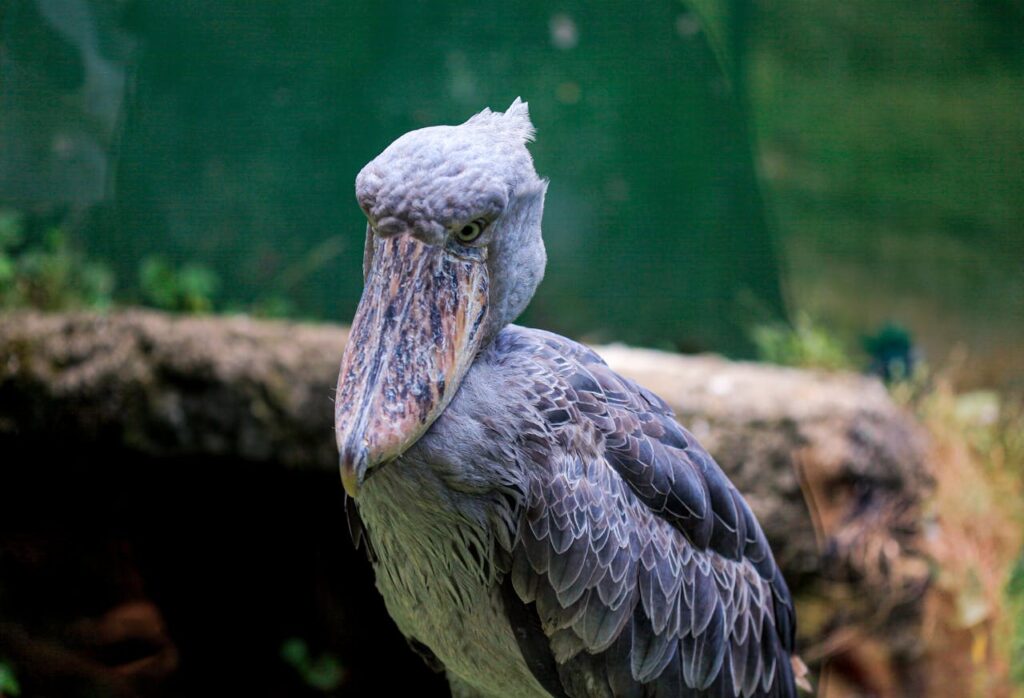With its massive, prehistoric-looking bill and piercing stare, the shoebill stork (Balaeniceps rex) is often called “the dinosaur bird.” This rare and fascinating creature draws the attention of bird enthusiasts and researchers alike. If you’ve ever wondered why the shoebill stork looks so ancient, how it hunts, or if it’s really dangerous, keep reading for the latest facts about this incredible bird.
What Is a Shoebill Stork?
The shoebill stork is a large waterbird found only in isolated freshwater swamps of central and eastern Africa. Despite its name, it is more closely related to pelicans and hamerkops than true storks. Shoebills can reach heights of 4.5 to 5.5 feet and weigh up to 12 pounds. Their most distinctive feature is a huge, shoe-shaped bill, which gives the bird its unique dinosaur-like appearance.
Quick Shoebill Facts
- Native to central and eastern African swamps
- Stands as tall as 5.5 feet
- Massive, shoe-like bill for hunting large prey
- Solitary and highly territorial
- Listed as Vulnerable by the IUCN due to habitat loss and trade
Why Are Shoebill Storks Called ‘Dinosaur Birds’?
The shoebill stork’s impressive size, fierce predatory skills, and ancient appearance make it look like something from the age of dinosaurs. Its powerful beak and stalking movements are reminiscent of prehistoric birds, earning it the nickname “dinosaur bird.”
| Feature | Shoebill Stork | Typical Modern Stork |
|---|---|---|
| Bill Shape | Massive, shoe-shaped | Long, slender, pointed |
| Height | 4.5-5.5 feet | ~3-4 feet |
| Related Birds | Pelicans, Hamerkops | Herons, Ibises |
| Hunting Technique | Stand and wait, collapse strike | Stalk and spear |
Where Do Shoebill Storks Live?
Shoebills inhabit large, remote freshwater swamps dotted with reeds, papyrus, and grasses. Their range extends from South Sudan and Ethiopia down to northern Zambia, but they are never common anywhere. The best chance to spot a shoebill is in places like the Bangweulu Wetlands in Zambia or the papyrus swamps of Uganda.
How Does the Shoebill Stork Hunt?
The shoebill’s hunting strategy is both unique and highly effective:
- Stand & Wait: It stands perfectly still for long periods, blending into reeds and grasses, waiting for fish or amphibians to approach.
- Wade & Walk Slowly: Sometimes, it moves stealthily through shallow water.
- Collapse Strike: When prey is close, the shoebill lunges forward in a dramatic “collapse,” scooping up the prey (often along with some vegetation).
- Sway & Decapitate: It sways its bill side-to-side to remove vegetation, then usually decapitates the prey before swallowing it whole.
Their favorite meals include large lungfish, catfish, tilapia, snakes, and even baby crocodiles. Shoebills are often found in poorly-oxygenated waters, where fish must come to the surface to breathe, making them easier targets.
Social Behaviors: Are Shoebill Storks Aggressive?
Shoebill storks are solitary by nature. They rarely tolerate the presence of other shoebills, even their own mates outside of nesting season. You’ll usually see only one bird at a time, except during nesting or if food is extremely scarce. They communicate with low bill-clattering sounds and, on rare occasions, a “mooing” or “meowing” vocalization. zootampa.org
- Shoebills are not a threat to humans—they are shy and prefer to stare rather than approach.
- Chicks beg for food with soft, hiccupping calls.
- Nesting pairs forage far apart within their territory.
Unique Shoebill Parenting and Nesting Habits
Shoebills usually nest on floating vegetation in the middle of the swamp. One truly unusual behavior is “egg-watering”: the parent carries water or wet grass in its huge bill and pours it over the eggs, rolling them to keep them cool in the African sun.
Why Are Shoebill Storks Endangered?
The shoebill stork is currently listed as Vulnerable by the IUCN, with population estimates ranging from 3,300 to 5,300 individuals. Their biggest threats include:
- Habitat loss from wetland drainage for farming and development
- Disturbance from fishing, livestock, and tourism
- Illegal hunting and chick capture for the pet trade
- Climate change affecting wetland stability
Conservation programs, like the Shoebill Nest Protection Programme in Zambia, now employ local community members to protect nests and rear chicks for release, offering hope for this iconic species. africanparks.org
Frequently Asked Questions
Is the Shoebill Stork Dangerous?
No, shoebill storks are not dangerous to humans. If you approach one in the wild, it is more likely to stare at you than attack. Their fierce look might be intimidating, but they prefer solitude and avoid conflict. animaldiversity.org
What Makes the Shoebill’s Bill Special?
The shoebill’s bill is one of the largest and strongest among birds, designed to snatch and grip large, slippery prey. The hooked tip helps in killing and decapitating prey before swallowing.
Where Can I See a Shoebill in the Wild?
Your best chances are in the marshes of Uganda or the Bangweulu Wetlands of Zambia, always with a skilled local guide since these birds are elusive and areas can be difficult to reach. birdlife.org
Do Shoebill Storks Migrate?
Shoebills are non-migratory but will make small local movements between nesting and feeding areas.
The shoebill stork remains one of the world’s most mysterious and awe-inspiring birds. As efforts grow to protect its wetlands and educate local communities, you can help by supporting conservation groups and sharing what you’ve learned about this living dinosaur.


